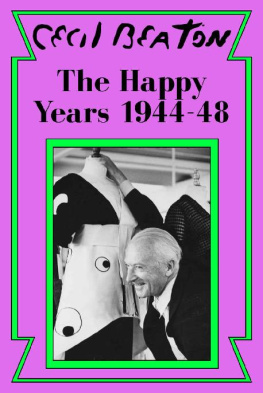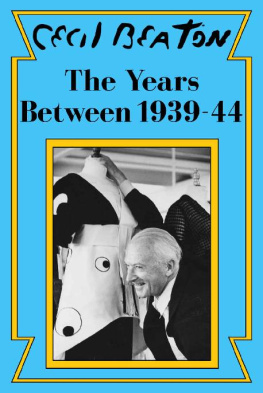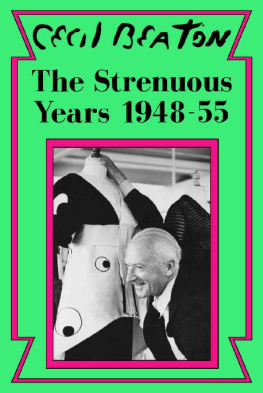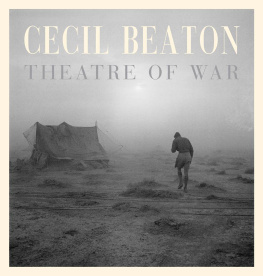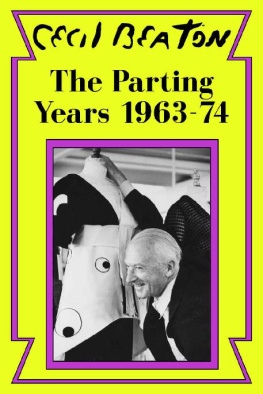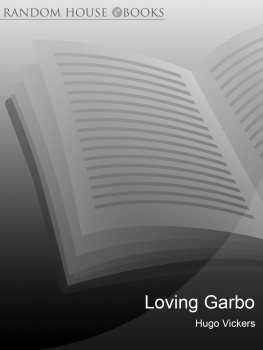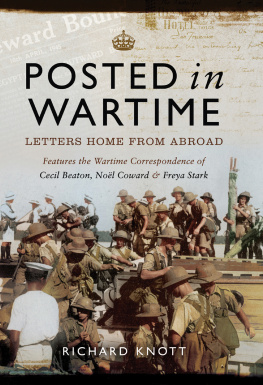Table of Contents
Foreword to the New Edition
I welcome the republication of the six volumes of Cecil Beatons diaries, which so delighted readers between 1961 and 1978. I dont know if Cecil himself re-read every word of his manuscript diaries when selecting entries, but I suspect he probably did over a period of time. Some of the handwritten diaries were marked with the bits he wanted transcribed and when it came to the extracts about Greta Garbo, some of the pages were sellotaped closed. Even today, in the library of St Johns College, Cambridge, some of the original diaries are closed from public examination, though to be honest, most of the contents are now out in the open.
The only other person who has read all the manuscript diaries is me. It took me a long time to get through them, partly because his handwriting was so hard to read. I found that if I read one book a day, I had not done enough. If I did two in a day, then I ended up with a splitting headache! This in no way deflected from the enormous enjoyment in reading them.
Altogether there are 145 original manuscript diaries dating from Cecil going up to Cambridge in 1922 until he suffered a serious stroke in 1974. A few fragments of an earlier Harrow diary survive, and there is a final volume between 1978 and 1980, written in his left hand. 56 of these cover his time at Cambridge, some of which appear in The Wandering Years (1961) . 22 books cover the war years, and were used for The Years Between (1965), and nine books record his My Fair Lady experiences, some of which appear in The Restless Years (1976) and were the basis for Cecil Beatons Fair Lady (1964). These six volumes probably represent about ten per cent of what Cecil Beaton actually wrote.
The diaries attracted a great deal of attention when first published. James Pope-Hennessy wrote of Cecils thirst for self-revelation, adding that the unpublished volumes were surely the chronicle of our age. Referring to Cecils diaries, and those of Eddy Sackville-West, he also commented: We could not be hoisted to posterity on two spikier spikes.
I have to tell the reader that these volumes were not always quite the same as the originals. Some extracts were rewritten with hindsight, some entries kaleidoscoped and so forth. Certain extracts in these six volumes were slightly retouched in places, in order that Cecil could present his world to the reader exactly as he wished it presented. And none the worse for that.
Hugo Vickers
January 2018
Preface Note
I started jotting down diary notes when I was still at Harrow School. But it was as a bewildered first-year undergraduate at Cambridge that I took to keeping a diary in earnest: in this my private and most trivial thoughts were confined. And so began the habit of a lifetime.
Never while writing my diaries did it enter my head (not, at least, until recently) that these outpourings might one day be published. It was only eight years ago that I began to re-read my notebooks and realized, to my own surprise, that these youthful records of life in the twenties and thirties might have some public interest as a piece of personal period history. I decided to publish them.
Then one thing led to another. That first volume was honest and frank, even if painful, and was not doctored for publication. Subsequent volumes, I was sure, must continue in the same vein. What I did not foresee was that time would so quickly catch up with me, and that soon I would be publishing intimate descriptions of people who might think my disclosures slightly premature.
Some who appear in this volume may consider that things that were said, or happened, twenty years ago are still not sufficiently a part of history to be aired in print. If I have offended any friends I hope they will believe that it was far from my wish to do so. Least of all have I wanted to cause any pain to the woman who occupied my thoughts (and the bulk of my diary entries) in the years just after the war. I have tried to remain truthful, and I hope to publish future diaries. But if I were to omit the central character from this present volume it would cause a complete hiatus, and denigrate a relationship that was, for ten years, meaningful and pertinent, and reduce it to the level of an episode. Moreover, it would not be natural or justifiable to myself and still less to her if I effaced my recollections of this remarkable person.
C.B. 1968
Part I: London and Paris, 1944-5
LONDON IN 1944
September 1944: 8 Pelham Place, London
The flying bombs and those beastly V2s, exploding from out of nowhere, have created new havoc in London since I left for the Far East nearly a year ago. After travelling home via the States and enjoying for a spell the glitter of New York life, I was stunned to see such wreckage to poor inoffensive streets which contain no more important a target than the pub at the crossroads. Miles of pathetic little dwellings have become nothing but black windowless faades. Old, torn posters hang from scabrous walls, the leaves on trees have changed to yellow under a thick coating of cement powder. Nothing has been given a wash or a lick of paint. Everythings so shabby and sordid. The poverty displayed in shop windows those that still have glass in them reminds me of Moscow in 1935 and is just as depressing.
After celebrating the liberation of Paris in New York I thought that things might be looking up a bit everywhere. But no. War in England is more total than ever, hardships always increasing. People look terribly tired and tend to be touchy and quarrelsome about small things.
Yet, in spite of all the horror and squalor, London has added beauty. In its unaccustomed isolation above the wastes of rubble, St Pauls is seen standing to supreme advantage, particularly splendid at full moon. The moon in the blackout, with no other light but the stars to vie with, makes an eighteenth-century engraving of our streets. St Jamess Park, without its Victorian iron railings, has become positively sylvan.
Even in the centre of the town there are aspects of rural life. While the buses roar along Oxford Street the gentler sounds of hens and ducks can be heard among the ruins of nearby Berners Street. There are pigs sleeping peacefully in improvised styes in the craters where seeds that have been buried for three hundred years have propagated themselves and make a display of purple milkwort and willow-herb. The vicar of St Jamess, Piccadilly, counted twenty-three different varieties of wild plant behind his bombed altar.
Each evening at nine, everyone stops as for the muezzin call to prayer in Mohammedan countries for the evening news. It is almost an offence to telephone at the hour of the BBC bulletins, and as you walk along the pavements the announcers voice echoes through all open windows. Every language is spoken on the pavements, and in some parts the English voice is seldom heard. Baseball crowds cheer in Hyde Park while in the long twilight of double summer-time Piccadilly Circus is transformed by the khaki figures squatting along the wall of sandbags around Eross statue, into the sleepy Southland from which many of these raw recruits have come.
October
Hugh Francis of the M. of I. still finds me odd propaganda jobs. These take me to Jarrow, Nottingham or Bradford. Here my Rolleiflex is aimed at the continuing war effort: at unphotogenic scientists in laboratories, at weather men foretelling the future or measuring the invisible sun. But now that the end of war is in sight, at any rate on the European horizon, my particular contributions to the national cause seem more ineffectual than ever. My enthusiasm on these expeditions is becoming very forced, and I notice all the more keenly the pin pricks: trains are frigid, food unappetizing surely even for animals and the discomfort and tyranny inflicted on the unfortunate guest of the average English hotel is past being a wry joke.

